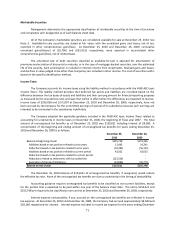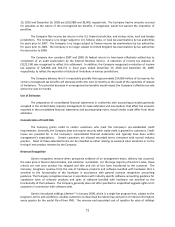Garmin 2010 Annual Report Download - page 93
Download and view the complete annual report
Please find page 93 of the 2010 Garmin annual report below. You can navigate through the pages in the report by either clicking on the pages listed below, or by using the keyword search tool below to find specific information within the annual report.
81
The Company recognized a $29,615 deferred tax asset during 2010 for the future tax benefit of the fair market
value step-up in basis of intangible assets related to the redomestication to Switzerland and local statutory tax
reporting requirements. The deferred tax asset was recognized as an increase to Additional Paid-In Capital in
2010.
At December 25, 2010, the Company had $48,784 million of tax credit carryover which includes $46,234
of Taiwan surtax credit with no expiration. There is a full valuation allowance for the Taiwan surtax credits.
Additionally, the Company had $479 in Taiwan investment credit which will expire in 2012. The valuation
allowance increased by $15,735 during 2010 including $12,109 related to Taiwan surtax credits.
7. Fair Value of Financial Instruments
As required by the Financial Instruments topic of the FASB ASC, the following summarizes required
information about the fair value of certain financial instruments for which it is currently practicable to estimate
such value. None of the financial instruments are held or issued for trading purposes. The carrying amounts and
fair values of the Companys fiaial istuets ae as follos:
Carrying Fair Carrying Fair
Amount Value Amount Value
Cash and cash equivalents $1,260,936 $1,260,936 $1,091,581 $1,091,581
Restricted cash 1,277 1,277 2,047 2,047
Marketable securities 801,819 801,819 766,047 766,047
December 26, 2009
December 25, 2010
Fo etai of the Copas fiaial istuets, iludig aouts eeiale, aouts paale ad othe
accrued liabilities, the carrying amounts approximate fair value due to their short maturities.
8. Segment Information
The Company operates within its targeted markets through four reportable segments, those being related
to products sold into the marine, automotive/mobile, outdoor/fitness, and aviation markets. For external reporting
purposes, we aggregate operating segments which have similar economic characteristics, products, production
processes, types or classes of customers and distribution methods into reportable segments. All of the Copas
reportable segments offe poduts though the Copas etok of idepedet deales ad distiutos as
ell as though OEMs. Hoee, the atue of poduts ad tpes of ustoes fo the fou reportable segments
a sigifiatl. The Copas aie, autootie/oile, and outdoor/fitness segments include portable
global positioning system (GPS) receivers and accessories sold primarily to retail outlets. These products are
podued piail the Copas susidia i Taia. The Copas aiatio poduts ae portable and
panel mount avionics for Visual Flight Rules and Instrument Flight Rules navigation and are sold primarily to
aviation dealers and certain aircraft manufacturers.
The Copas Chief Eeutie Offie has ee idetified as the Chief Opeatig Decision Maker
(CODM). The CODM evaluates performance and allocates resources based on income before income taxes of each
segment. Income before income taxes represents net sales less operating expenses including certain allocated
general and administrative costs, interest income and expense, foreign currency adjustments, and other non-
operating corporate expenses. The accounting policies of the reportable segments are the same as those described
in the summary of significant accounting policies. There are no inter-segment sales or transfers.
























